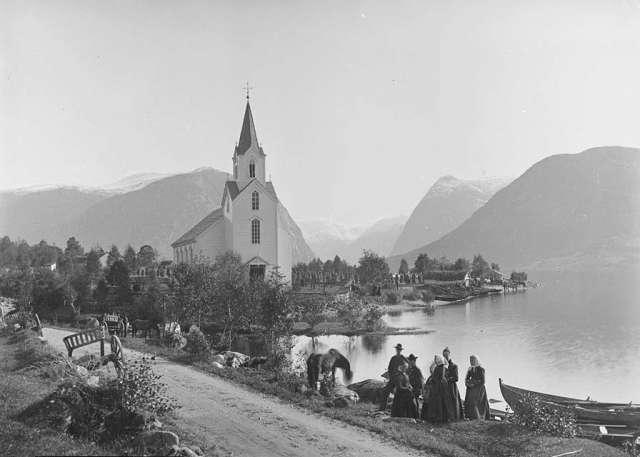
This photo, from the 1880s or 1890s, shows the little church that my grandmother, a life-long Lutheran, attended until she left for America at eighteen (i.e., during this very time). The farm on which she was born and raised, Søgnesand, is at the very end of the KJøsnesfjord, the area in the distance, enclosed by mountains, at the center of the photograph. They had to travel to the church by boat or, in the winter, sometimes by walking across the iced-over lake. I’ve visited this area several times and love it very much. The farm still belongs to relatives of mine. My grandmother died when I was five years old, and I scarcely remember her. I look forward to seeing her again.
(Public domain photo from Wikimedia Commons)
Three passages taken from P.M.H. Atwater, The Big Book of Near-Death Experiences: The Ultimate Guide to What Happens When We Die (Charlottesville, VA: Hampton Roads Publishing Company, 2007):
As he lay dying on the ground near his mangled car, comedian Sam Kinison was heard talking softly with an unseen presence. An individual at the scene later told reporters from the Las Vegas Sun what he had said as he conversed with “somebody upstairs.” Sam pleaded, “I don’t want to die,” then he paused as if listening to a voice speak to him. “But why?” he countered. Then he replied, “Okay, okay, okay,” with the last “okay” so soft, so peaceful, and so sweet, it was as if Sam’s concerns were put to rest by someone he loved and fully trusted. He then relaxed, and died. (282)
Seven people died in a terrible car accident, but one survived — a six-year-old child named Ashley. In an article carried in the Wisconsin State Journal, Madison, Wisconsin therapist Karen Moore, who worked with the girl afterward, said Ashley would often point to the hospital ceiling where she saw her dead mother and father. “Don’t you see them?” she’d ask. “No,” Karen replied, “what are they doing?” “Oh, they’re laughing and eating.” “It was eerie,” the therapist stated later. “There was nothing to indicate she was hallucinating. This went on for several weeks, and then they moved her to Rusk Rehabilitation Center, and I remember her saying, “They’re gone. I can’t find them anymore.” (282-283)
Occasionally, when the dead are seen by the living, they are said to look like foggy apparitions or projections from a motion picture show. Most accounts, though, claim that the dead are 100-percent real-looking, and as lively as when they last breathed a puff of air. Notable differences include: They always look younger than when last seen; they’re cured of any illness, handicap, or injury they may have had; and they’re aglow with a special light that seems to emanate from within them. In other words, the dead that return generally look better than before — and they “shine.” (283)











